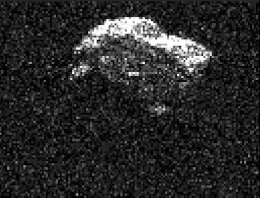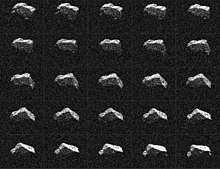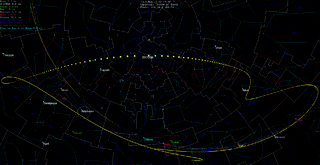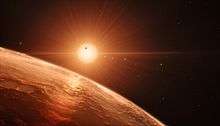2017 BQ6
 Radar image of 2017 BQ6 | |
| Discovery [1][2] | |
|---|---|
| Discovered by | Space Surveillance Telescope |
| Discovery date | Lincoln Lab's ETS |
| Designations | |
| MPC designation | 2017 BQ6 |
| E2017-C83 | |
| NEO · Apollo · PHA [1] | |
| Orbital characteristics [1] | |
| Epoch 4 September 2017 (JD 2458000.5) | |
| Uncertainty parameter 3 | |
| Observation arc | 130 days |
| Aphelion | 2.9802 AU |
| Perihelion | 0.9133 AU |
| 1.9468 AU | |
| Eccentricity | 0.5309 |
| 2.72 yr (992 days) | |
| 65.132° | |
| 0° 21m 46.08s / day | |
| Inclination | 9.0020° |
| 133.03° | |
| 43.562° | |
| Earth MOID | 0.0132 AU (5.1 LD) |
| Physical characteristics | |
| Dimensions | 0.156 km (calculated)[3] |
|
2.150 h[3] 3 h[1] | |
| 0.20 (assumed)[3] | |
| S (assumed)[3] | |
| 21.4[1][3] | |
|
| |
2017 BQ6 is a sub-kilometer asteroid on an eccentric orbit, classified as a near-Earth object and potentially hazardous asteroid of the Apollo group, approximately 150 meters in diameter. It was discovered on 26 January 2017, by the Space Surveillance Telescope at Lincoln Laboratory's ETS (Atom Site) and passed within 6.6 lunar distances of Earth on 7 February 2017 at 6:36 UT.[1][2]
Radar imaging
Its closest approach was observed by NASA's Goldstone Solar System Radar in California's Mojave Desert, determining it to have a number of angular flat surfaces similar to a polyhedral die.

Orbit
2017 BQ6 orbits the Sun with a semi-major axis of 1.95 AU at a distance of 0.9–3.0 AU once every 2 years and 9 months (992 days). Its orbit has an eccentricity of 0.53 and an inclination of 9° with respect to the ecliptic. It has an Earth minimum orbital intersection distance of 0.0132 AU (1,970,000 km), which corresponds to 5.1 lunar distances.[1]

Physical characteristics
Based on an absolute magnitude of 21.4 and an assumed albedo for stony S-type asteroids of 0.20, 2017 BQ6 measures 156 meters in diameter.[3] The body has a rotation period of 2.15 hours and a brightness amplitude of 0.38 magnitude (U=2).[3]
References
- 1 2 3 4 5 6 7 "JPL Small-Body Database Browser: (2017 BQ6)" (2017-06-05 last obs.). Jet Propulsion Laboratory. Retrieved 21 November 2017.
- 1 2 "2017 BQ6". Minor Planet Center. Retrieved 21 November 2017.
- 1 2 3 4 5 6 7 "LCDB Data for 2017 BQ6". Asteroid Lightcurve Database (LCDB). Retrieved 21 November 2017.
External links
- Meet Asteroid 2017 BQ6 — A Giant, Spinning Brick 12 Feb, 2017 by Bob King
- Asteroid Resembles Dungeons and Dragons Dice February 10, 2017
- Goldstone Radar Observations Planning: comet 45P/Honda-Mrkos-Pajdusakova, 2015 BN509, 2017 BW, 2013 WT67, 2017 BQ6, 2013 FK, and 2017 BY93
- List Of The Potentially Hazardous Asteroids (PHAs)
- Asteroid Detection with the Space Surveillance Telescope
- 2017 BQ6 at the JPL Small-Body Database

